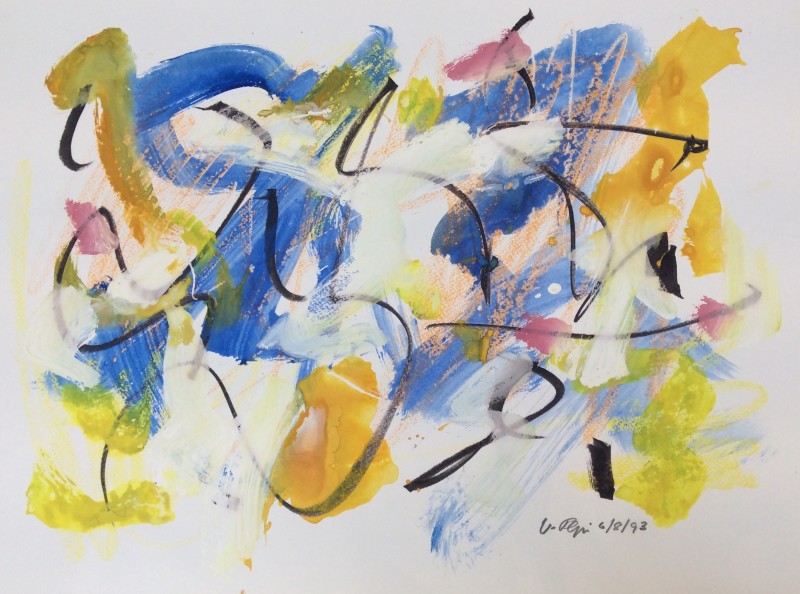
QUOGUE GALLERY
FOR IMMEDIATE RELEASE
February 13th, 2017
Hamptons Quogue Gallery Comes to Fritz Porter in Charleston
Show Dates: March 1 to March 31, 2017
Exhibition Spotlights of a Group of Abstract Expressionist Painters
Quogue, New York, February 13, 2017. Hamptons-based Quogue Gallery has announced that it will be exhibiting at Fritz Porter in Charleston, South Carolina the work of ten artists: eight painters – Von Allen, Holland Cunningham, Raymond Hendler, Le Corbusier, Mary Montes, Vincent Pepi, Arthur Pinajian, and Melinda Zox; one assemblage artist – Liz Sloan and one photographer – Barbara Vaughn. The exhibition’s main focus is on work painted or influenced by the New York School. The phrase “New York School” is an umbrella term applied to the loose-knit group of 20th century painters based in New York City in the 1940s, 50s and 60s. The term has become synonymous with the art movement known as Abstract Expressionism. The exhibition will take place from March 1 to March 31, 2017. Fritz Porter is located at 701 East Bay Street # 106 Charleston, South Carolina and is opened 10 am to 6 pm Monday through Saturday.
Von Allen’s bold paintings and delicate drawings arrive at the intersection of two significant influences: Abstract Expressionism and the bond between music (notably jazz) and painting. Born in 1961 in Jacksonville, North Carolina, Von Allen went to California to study painting at the Village Center for the Arts in Palm Springs. He moved to New York directly after school, befriending Ruth Kligman, an artist who was an insider when the Abstract Expressionist movement was at its peak. She also was notable as the mistress of Jackson Pollock and Willem de Kooning. “Over the course of his remarkable career,” Kligman stated in 2004, “Von Allen has made an exceptional contribution to the body of Abstract Expressionist work worldwide, and ranks as one of our most important new masters of the genre.”
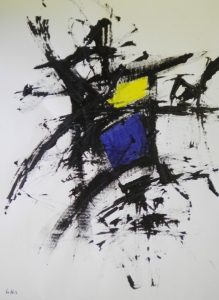
Elion, 2016 | Oil & Pastel on paper | 24” x 18”
Holland Cunningham is an emerging Abstract Expressionist painter with studios in New York City and on the East End of Long Island. Her inspiration comes from a passion for plein air painting as well as classic paintings of the renaissance and other periods that serve as a springboard for her conceptual abstractions on paper and canvas.
She uses various materials to create her soft palate works, such as oil, water-based media and photography. Cunningham studied art history and studio art at the University of Virginia, the Art Students League and the National Academy of Art and Design. She was a resident at the Bau Institute in Puglia, Italy, in the summer of 2012. Cunningham’s 2015 show at the Quogue Gallery was sold out. In a review of that exhibition, Charles A. Riley II of Hamptons Art Hub writes, “Cunningham manages to paint big on relatively modest planes of paper and canvas. Her palette is similar to Joan Mitchell, Helen Frankenthaler, Dan Christensen, and Cy Twombly –especially the white veil she modestly draws over many of her boldest touches of color. But the linear grammar is pure Hans Hoffmann and Robert Motherwell, whose black guidelines trace geometric and figural suggestions like a choreographer in the wings using a finger to start a pirouette onstage.”
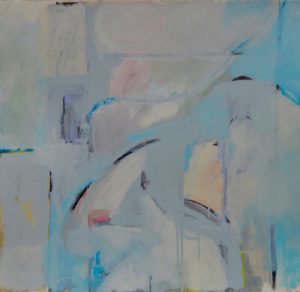
Chrystie 16, 2015 | Mixed media on paper | 33.75” x 35”
Raymond Hendler (1923 – 1998) studied in his native Philadelphia, at the Graphic Sketch Club, the Philadelphia College of Art, the Pennsylvania Academy of Art, and the Tyler School of Art (Temple University). In 1949, he traveled to Paris, where he continued his training at the Académie de la Grande Chaumière, on the G.I. Bill. In Paris, he exhibited at the Musée d’Art Moderne and was a founding member of Galerie Huit, the first American cooperative gallery in Europe. Other noted members included Sam Francis, Sidney Geist, Al Held, and Jules Olitski. Returning to New York in 1951, Hendler became part of the exploding Greenwich Village art scene. He was a voting member of the New York Artist’s Club from 1951 until its end in 1957. He met the leading figures in the New York School, including Pollock, de Kooning, Philip Guston, Franz Kline and the critic Harold Rosenberg. With Kline, he established a lifelong friendship that significantly informed his work. Over this same period, Hendler also was active in Philadelphia. At the Hendler Galleries (1952-1954), he exhibited the work of de Kooning, Kline, Pollock, and Jack Tworkov. He also introduced to America work made by friends in Paris, notably Francis, and Milton Resnick. During his forty-year teaching career, Hendler taught at the University of Minnesota; the Contemporary School of Art, Brooklyn; Parsons School of Design, New York; Pratt Institute, Brooklyn; School of Visual Art, New York; and Minneapolis College of Art. Hendler’s work can be found in numerous public and private collections in America and abroad. He is included in an important survey compiled in 2000 by Marika Herskovic, The New York School Abstract Expressionists: Artists Choice by Artists. In a review of Hendler’s 2014 show at the Quogue Gallery James Croak wrote, “Hendler is belatedly taking his proper place in the pantheon of those with whom he pioneered a major chapter in modern art.” The Hender exhibition was named one of the “Top Hamptons Show from 2014” by Hamptons Art Hub.
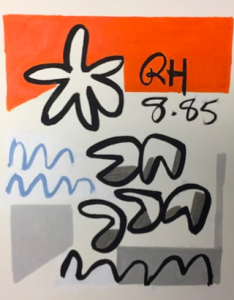
No. 50, August 1985 | Acrylic on paper | 12” x 10”
Le Corbusier (1887 – 1965) was a Swiss‐ French architect, designer, and painter. Before Le Corbusier became one of the seminal architects of the last century, he was a painter and an engraver. Yet, while his reputation and renown as a revolutionary and influential architect is undisputed, his paintings, prints and drawings remained almost unknown until his 70th year, despite the fact that Le Corbusier insisted that painting and architecture were inextricably bound. Based on a series of pastels, the Unité aquatints celebrate organic arrangements simply and masterfully blend color, line and form. One of Le Corbusier’s very last projects before his untimely death in 1965, the etchings were executed between 1963-1965. The portfolio was printed at the Atelier Crommelynck in 1965 and published in a single edition of 130.
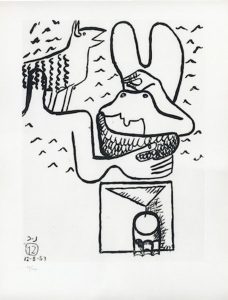
Unite, Plate 12, 1965 | Etching with aquatint | 22.50” x 17.80”
Mary Montes is an Abstract Expressionist painter who fuses representation with abstraction. While studying fine art at Barry University and the University of Miami she developed a painterly style that accentuates her mastery in drawing with a lively application of line and color. The result is an aesthetic distinctively her own. As a women painter, her sensitivity to the figure is beautifully melded with an emotive portrayal of her subject matter.
In 2006, she would have the opportunity to continue her training at the Department of Art at the University of Miami with master painter, Brian Curtis and her art took a different direction. Although focused on classical drawing and painting, she soon began dabbling in more abstracted works, clearly influenced by the likes of Willem de Kooning, Richard Diebenkorn and Robert Rauschenberg whom she came to know in his later years. She continues to work under the mentorship of Curtis to this day. Montes’ current work is primarily oil and pastel, incorporating watercolor into her large-scale abstract paintings. Her paintings capture the immediacy of color, while preserving a thoughtful drawing quality.
Montes’ work has been exhibited in the Lowe Art Museum, College of Arts and Science at Miami University, Andy Gato Galleries, Museum of Contempory Art (North Miami), and private art shows in Miami Beach. Her most recent show was in December 2015 at the Spectrum Art Fair during Art Basel/Miami week.
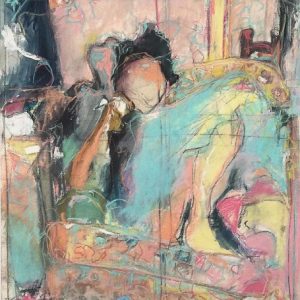
Muse, 2015 | Mixed media on paper | 38” x 26”
Liz Sloan is an emerging assemblage artist whose work comes out of a unique painting style that she calls Elemental Energy. A foundation of outlined ovals informs the kinetic flow of her work. She brings a design background to her art – through a successful jewelry design business that she ran for 10 years and as an interior designer – before deciding to concentrate on her art full-time. During her time as a designer, she continued to nurture her interest in art. She has been painting on and off for 35 years under the tutelage of Bruce Dorfman at the Art Students League of New York. Sloan majored in fine arts at Colgate University. Most recently, she has had solo exhibitions at Scope, Miami Beach (2016), the Quogue Gallery (2016) and Mark Humphrey Gallery in Southampton, New York (2015). She has appeared in group exhibitions at Market Art & Design in Bridgehampton, New York (2016), Samuel Own Gallery in Nantucket, Massachusetts (2016), and First Street Gallery in New York City (2015). She was featured in On the Inside Magazine in a 2016 article entitled, “Liz Sloan Book of Rings”.
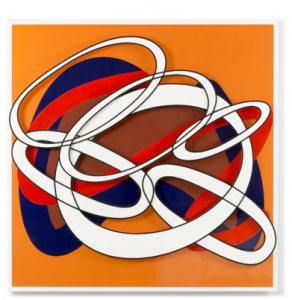
Golden Rings, 2016 | Sintra, Flex Print, Acrylic Paint, Acrylic | 48” x 48”
Vincent Pepi is an Abstract Expressionist painter associated with the New York School. His contribution to American art includes some of the foremost examples of action painting, produced consistently over the course of the second half of the 20th century. His art parallels the works of Jackson Pollock, Willem de Kooning, Franz Kline, Conrad Marca-Relli and others. He adapted the automatic techniques of the Surrealists and transformed it into his own kind of gesture painting. Vincent Pepi studied at Cooper Union and Pratt Institute. In 1949 he went to Rome, Italy. His academically trained teacher in Italy, Beppe Guzzi, helped him to incorporate rigorous discipline into his painting, as well as introducing him to a number of important Italian painters and sculptors. Three years later, in 1951, Pepi joined with many of the innovators of Action Painting in New York City. Upon his return to the United States, Pepi studied briefly with Hans Hofmann. Along with other first generation Abstract Expressionists, he showed his work at the Stable Gallery in 1953 and at the March Gallery on Tenth Street, from 1955 until its closing in 1960. Pepi attended the “Artists’ Club” from time to time, but preferred his own studio and a more solitary existence. Pepi defines himself as an academic artist, but one who felt he had to take that “main highway between Cézanne and Kandinsky”. His paintings do indeed, reveal a Cézanne-like underpinning of abstract structure, while adopting the free improvisatory phase of Kandinsky at the same time. It is the revelation of the unconscious that Pepi seeks in his work. He wants his work to be spontaneous and uncontrived. Pepi’s work is in numerous private and public collections including the Smithsonian American Art Museum and the San Francisco Museum of Modern Art. Pepi is included in an important survey compiled in 2000 by Marika Herskovic, The New York School Abstract Expressionists: Artists Choice by Artists.
Pepi’s 2016 exhibition at the Quogue Gallery was ranked as one of the “Best Exhibitions on East End 2016” by Hamptons Art Hub. About the exhibition, Hamptons Art Hub wrote, “A stunning chromatic extravaganza from a living link to the abstract expressionist movement that made Manhattan the capital of the art world.”
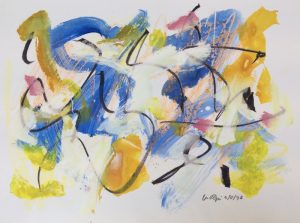
1128, 1993 | Mixed media | 18” x 24”
Arthur Pinajian (1914 – 1999) is an Abstract Expressionist painter. The late Dr. William Innes Homer, once dean of American art historians, was the first to conclude that the discovery of Arthur Pinajian presented one of the most compelling discoveries in the history of twentieth century American art: “Even though Pinajian was a creative force to be reckoned with, during his lifetime he rarely exhibited or sold his paintings. Instead, he pursued his goals in isolation with the single-minded focus of a Gauguin or Cézanne, refusing to give up in the face of public indifference. In his later years, he could be compared to a lone researcher in a laboratory pursuing knowledge for its own sake. His exhaustive diaries and art notes make it clear that he dedicated all of his days to his art. He was passionate and unequivocally committed. Ultimately, Pinajian’s work reflects the soul of a flawed, yet brilliant, artistic genius. When he hits the mark, especially in his abstractions, he can be ranked among the best artists of his era.” Critics and collectors enthusiastically agreed, and in 2013 Pinajian was featured on ABC’s “Good Morning America” program as “ the unlikely discovery that has rocked the art world.”
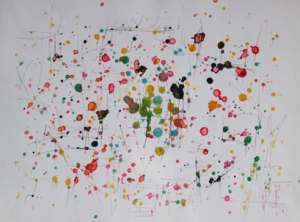
1861, 1973 | Gouache on paper | 18” x 24’
Melinda Zox is a young emerging Abstract Expressionist painter who studied at the School of Visual Arts in New York City under Frank Roth. Zox is the daughter of abstract painter Larry Zox who played an essential role in the Color Field discourse of the 1960s and 1970s and his artist wife Jean Glover Zox. As a result, she was raised in the heart of the downtown New York City art scene. Her childhood, she says, was “a continual lesson in the experience of art and creativity. Art, color, and expression were part of our daily live and almost every conversation.” About her work, Zox says that “I am drawn to color and influenced by bold, strong lines as well as the dynamic, powerful shapes in metal structures and the shadows they create.”
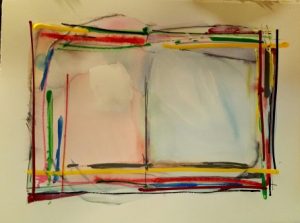
Color Swipe, 2016 | Mixed media | 22” x 29”
Barbara Vaughn is an acclaimed photographer who takes as her subject matter bodies of water from across the world. Vaughn’s vibrant, large-scale photographs harness nature to realize abstraction and explore the visual phenomenon of perspective. Seeking to create images that move beyond the confines of representational photography, she takes cues from Abstract Expressionism, Surrealism and Cubism in her unusual depictions of ordinary locales. By photographing fragments of reflections in the undulating waters of Mediterranean ports, European canals, and coastal marinas of the U.S., she captures images that prevent the viewer from recreating the original scene, thereby enticing us to engage our powers of imagination.
After earning her BA from Princeton University, Vaughn studied at the International Center of Photography in New York. Her work has been published in numerous books and periodicals, including The New York Times, Vanity Fair, Time, Vogue and Art in America. In addition, she has had many solo and group shows over her thirty plus year career. Most recently, Vaughn’s work was included in the 2016 group show called “Water | Bodies” curated by Eric Fischel & David Kratz at the Southampton Art Center in Southampton, New York.
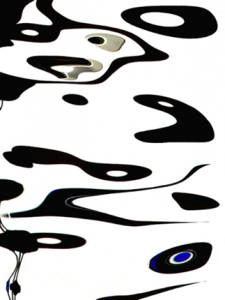
Apokopes II, 2014 | Archival pigment print | 40” x 30”
About Quogue Gallery
As Quogue’s first and only private art gallery, the Quogue Gallery is a dynamic new space in the Hamptons where artists, collectors, and art enthusiasts can meet and share their common passion for serious artistic investigation and appreciation. The gallery’s mission is to present a program of artistic excellence not limited to any genre or medium. Its focus is on modern and contemporary art created by emerging, established and historically important artists. An essential aspect of the mission is to establish the gallery as an active, vibrant, and inventive participant in the Hamptons art panorama, with artist talks and events that significantly contribute to the modern and contemporary art discourse.
Contacts:
Chester Murray | QUOGUE GALLERY
44 Quogue Street, Quogue, NY 11959
T 203 321 9427 | E chester@quoguegallery.com | W quoguegallery.com
Christy Murray | QUOGUE GALLERY
44 Quogue Street, Quogue, NY 11959
T 203 981 8260 | E christy@quoguegallery.com | W quoguegallery.com